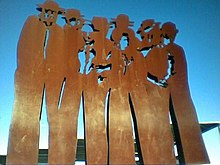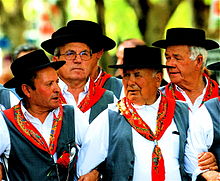Cante Alentejano
The Cante Alentejano is a traditional polyphonic chant from the lower Alentejo , a region in southern Portugal . As since 2011 been the fado , is also since 2014 Cante on the List of Intangible Cultural Heritage of Humanity of UNESCO .
The song " Grândola, Vila Morena " by the oppositional songwriter José Afonso is in the style of the Cante Alentejano and can be considered the best-known example of this singing style. On April 25, 1974, the play was the decisive slogan in the Carnation Revolution , which ended Europe's oldest dictatorship. The revolution was particularly enthusiastically received in the Alentejo and had a particularly deep impact there.
characterization
The Cante Alentejano ( Portuguese , roughly "Alentejanischer Gesang") is a musical tradition from the southern part of the Alentejo , more precisely from a number of counties in the Beja district , in particular Serpa , Moura , Aljustrel , Castro Verde , Ourique , Alvito , Almodôvar and Cuba .
It is performed exclusively through voices, entirely without the use of musical instruments .
A single part ( ponto ) provides the melody and text line, into which the choir ( alto ), which can number up to 30 people or more, then comes up and repeats them alternately. Usually a second single part appears as a ponto .
The choirs perform their songs both standing and walking slowly and uniformly, mostly with arms crossed.
Both traditional and contemporary, newly created texts and melodies are sung. The texts deal with everyday issues, mainly from the areas of work, family and social injustice.
Mostly men sing the cante , but there are also female groups. Mixed choirs are not common due to the strongly differing pitches.
There are no professional singers or choirs in the Cante . They sing on special occasions and dressed in traditional costumes , but also spontaneously, usually in the evenings in the region's taverns.
history

Since the extensive donations to knights after the Medieval Reconquista, a feudal system of landless farm workers and a few large landowners has prevailed in the region , in contrast to the predominantly small-scale structures with their own land in northern Portugal. Singing was common here among the farm workers while working uniformly in the wide open countryside. Some musicologists trace the origins back to ancient Greek, Jewish and especially Moorish roots, but these are so far only unsubstantiated assumptions.
The Cante Alentejano developed from these farm workers' songs, which is sung here not only by farm workers. The Cante known today originated in the region towards the end of the 19th century, with the first industrial developments in the mines and intensified agriculture, especially wheat cultivation. The first registered choral society was founded in 1926, among the miners of the Mina de São Domingos , and a second society followed in Serpa in 1927 .
Since 2013, the Serpa City Council has been striving for the Cante Alentejano to be included on the UNESCO Representative List of the Intangible Cultural Heritage of Humanity , with the support of the Baixo Alentejo Region Tourist Office. The publication of the book “Cancioneiro do Cante Alentejano” with two CDs at Tradisom in early 2013 also contributed to the dissemination and support of the application, as did the award-winning film “ Alentejo, Alentejo ” by the Franco-Portuguese director Sérgio Tréfaut 2014. On November 27, 2014 the UNESCO commission in Paris unanimously accepted the application for inclusion in the list and described the candidacy as exemplary.
Since then, the Casa do Cante (Portuguese for "House of the Cante"), based in Serpa, has been representing the interests of the Cante Alentejano and maintaining the traditions around the Cante. To this end, the association develops a number of initiatives, supports events, and conducts public relations work. a. with the publication of a magazine.
Also in the Portuguese public and on the part of politics and the nationwide cultural industry, the Cante has experienced a strong increase in recognition and interest since its registration as a UNESCO cultural heritage site.
Web links
- Website of the Casa do Cante in Serpa (port.)
- Website on the Cante Alentejano at UNESCO (English, French and Spanish)
- Article about the Cante Alentejano by Deutschlandradio Kultur
- Collection of video clips and recordings of the Cante Alentejanos on YouTube
Individual evidence
- ↑ a b Entry of the Cante Alentejano in the UNESCO World Heritage List , accessed on July 25, 2016.
- ↑ Article about the Cante Alentejano on the German website www.portugal-kultur.de, accessed on July 25, 2016.
- ↑ a b German-language article about the Cante Alentejano on www.visitportugal.com, accessed on July 25, 2016.
- ↑ a b c "The" Cante Alentejano "conquers Portugal's metropolises" , article from April 9, 2015 by Deutschlandradio Kultur , accessed on July 25, 2016.
- ↑ Article about José Moças and his label Tradisom on the website of the University of Aveiro , accessed on July 28, 2016.
- ↑ O cante do Alentejo já é património mundial e UNESCO chamou-lhe exemplar - "The Cante des Alentejo is now a World Heritage Site and UNESCO called it exemplary" , article of November 27, 2014 in the Público daily newspaper , accessed on July 25, 2016.
- ↑ Website of Casa do Cante in Serpa (port.), Accessed on July 25, 2016.
